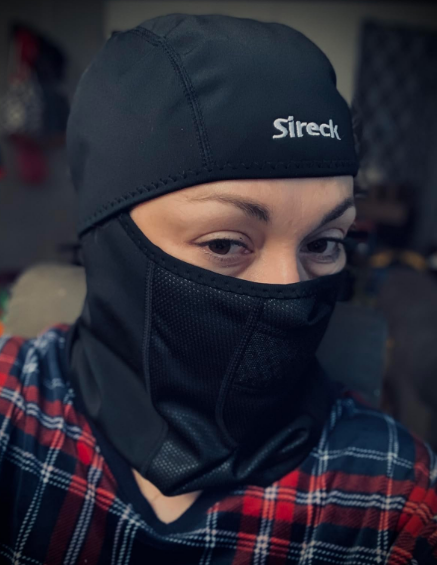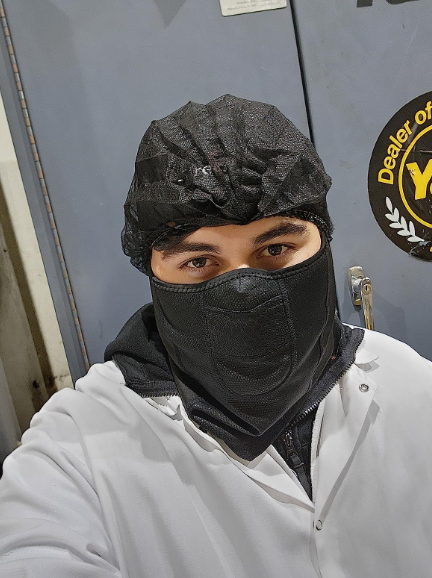Introduction to Cold Weather Balaclavas
A cold weather balaclava is a versatile headwear that provides comprehensive protection against the elements during winter activities. Traditionally made from warm, breathable materials, these ski masks cover the head, neck, and often face, offering a shield from cold air, wind, and snow. The design of balaclavas dates back to the Crimean War in the 1850s, where British soldiers wore similar garments to combat harsh weather conditions. Over the years, the utility and style of balaclavas have evolved, making them a popular choice for various outdoor activities.
The significance of balaclavas in winter sports and outdoor pursuits has grown considerably. Skiers, snowboarders, and other winter enthusiasts widely utilize these protective garments to maintain warmth and comfort during cold weather. The adoption of balaclavas among hunters and cyclists has also surged, as they require reliable thermal protection while remaining active in low temperatures. Similarly, motorcyclists often wear balaclavas beneath their helmets to guard against biting winds and freezing temperatures, highlighting the item’s multifaceted use.
As demand for outdoor recreational activities increases, so does the interest in high-quality cold weather balaclavas. Users seek out garments with advanced materials designed to manage moisture and provide insulation, ensuring that they remain warm without overheating. This growing market has led to innovations in balaclava design, including variations in fit and function to cater to the diverse needs of adventurers. The contemporary balaclava not only serves as a protective accessory but has emerged as a fashionable item, appealing to a broad audience looking for both functionality and style in their winter gear.

Key Features of Water Resistant and Windproof Fleece Materials
When selecting a cold weather balaclava, the choice of material plays a pivotal role in ensuring optimal comfort and protection. Fleece materials, particularly those engineered to be water-resistant and windproof, are commonly utilized in balaclava designs. The structure of these materials helps to create a barrier against the cold and wet conditions typically encountered during winter activities.
Water-resistant fleece is designed to repel moisture, making it ideal for snowy or damp environments. This feature works through a combination of fiber treatment and weave structure, where a hydrophobic finish is applied to the fabric. Consequently, it minimizes water absorption, allowing users to stay dry even when faced with light rain or melting snow. Moreover, advanced technological developments have resulted in breathable fleece options that maintain robust moisture management. This permeability allows sweat vapor to escape, preventing the build-up of humidity that can lead to discomfort during strenuous outdoor activities.
In tandem with water resistance, windproof capabilities are crucial for maintaining warmth. The fleece materials employed in high-quality balaclavas often incorporate a windproof membrane. This inert layer impedes cold airflow, thereby reducing heat loss while still remaining lightweight and flexible. The strategic juxtaposition of these features provides a thermal balance that keeps users insulated against harsh winds, a significant consideration for skiers and outdoor enthusiasts who are exposed to biting temperatures.
In summary, the adoption of advanced water-resistant and windproof fleece materials elevates the performance of cold weather balaclavas. These innovations contribute to a garment that not only traps warmth but also protects against external moisture and wind, making them essential for anyone engaging in winter sports or outdoor activities.

Benefits of Using a Balaclava in Cold Weather
A balaclava is an essential piece of winter gear that offers numerous benefits when facing cold weather conditions. Primarily, it serves as a protective barrier against extreme temperatures. The unique design covers the entire head, neck, and a portion of the face, ensuring that these vulnerable areas are insulated from harsh winter environments. This level of coverage significantly minimizes the risk of frostbite and other cold-related injuries that can occur during outdoor activities.
Additionally, a balaclava provides effective protection against wind chill, which can drastically lower perceived temperatures. When skiing or engaging in other winter sports, the combination of speed and cold air can lead to discomfort and hypothermia. A well-fitted balaclava shields the skin from biting winds, ensuring that enthusiasts can focus on their performance rather than on the elements. This functionality is particularly beneficial for athletes and hobbyists who often face prolonged exposure to cold weather.
Moisture management is another noteworthy advantage of wearing a balaclava during winter activities. Many balaclavas come equipped with moisture-wicking fabrics that draw sweat away from the skin, keeping the wearer dry and warm. This is crucial during high-energy activities like skiing or snowboarding, where perspiration can quickly lead to chilling when temperatures drop. By maintaining a comfortable microclimate, a balaclava enhances overall performance and enjoyment during outdoor pursuits.
Moreover, the versatility of a balaclava should not be overlooked. It can be used alone or layered under helmets, hoods, or hats, providing a customizable level of warmth and protection. Whether you are snowshoeing, hiking, or engaged in any other winter sport, a balaclava can significantly improve comfort and enhance the experience, allowing users to fully embrace the beauty of winter while staying safe from its challenges.

Styles and Designs of Balaclavas for Men and Women
Balaclavas, an essential accessory for winter enthusiasts, come in various styles and designs tailored to meet the diverse needs of both men and women. The primary distinction among these options lies in their coverage and functionality. Understanding the range of balaclavas available can help individuals make informed choices for their winter adventures.
One popular design is the full-face balaclava, which provides comprehensive protection against cold weather. This style covers the head, neck, and often the upper chest, leaving only the eyes exposed. It is particularly beneficial for skiers and snowboarders who require maximum warmth and wind resistance. The fabric is typically made from moisture-wicking materials, ensuring that sweat does not accumulate, thus enhancing comfort during high-intensity activities.
In contrast, half masks offer a more versatile solution with partial coverage. These designs generally shield the face and neck, while allowing for increased airflow and breathability. Half masks are well-suited for activities where full coverage may be unnecessary, such as hiking or running. They allow wearers to enjoy the outdoors while maintaining a cooler temperature during physical exertion.
Multifunctional balaclavas are another innovative option. These designs can be adapted for various uses, with features that enable them to be worn as a headband, neck gaiter, or face mask, depending on the wearer’s preference. Such adaptability makes them popular among outdoor adventurers who engage in multiple activities, from skiing to biking. This versatility ensures that individuals can remain comfortable and protected in different weather conditions.
Ultimately, selecting the right balaclava involves considering personal preferences and the specific requirements of the activities planned. With a variety of styles ensuring protection and comfort, everyone can find the perfect ski mask to enhance their winter experiences.

Choosing the Right Size and Fit
When selecting a balaclava, achieving the correct size and fit is essential for maximum comfort and protection against cold weather. A balaclava that is either too tight or too loose can impede its effectiveness, hindering its ability to shield against chilly temperatures and harsh winds. Therefore, proper measurement techniques must be employed prior to making a purchase.
To begin, measure the circumference of your head approximately one inch above the ears. This measurement serves as a primary guide to ascertain appropriate sizing. Many manufacturers provide sizing charts based on these measurements, which are often categorized as small, medium, large, and extra-large. It remains crucial to read the specific sizing guide provided by the brand because dimensions can vary significantly, affecting fit and comfort.
Additionally, consider the fabric of the balaclava. Materials that feature a degree of stretch can accommodate slight variations in size while still maintaining a snug fit. This elasticity can enhance comfort levels and prevent the balaclava from slipping during winter activities such as skiing or snowboarding. When trying on a balaclava, it is advisable to check for areas that may feel too tight or constricting, as these can cause discomfort over extended wear.
Furthermore, a balaclava should provide adequate coverage without impairing mobility. Ensure that the design allows for freedom of movement in the head and neck area. A well-fitted balaclava should sit snugly without compromising heat retention or breathability. Over time, the proper fitting will significantly improve the balaclava’s ability to provide protection against cold weather, enhancing your overall winter experience.
Top Uses of Balaclavas in Outdoor Activities
Balaclavas have become an essential piece of gear for various outdoor activities, especially in cold weather conditions. One of the most common uses for a balaclava is during skiing. Ski enthusiasts appreciate the protection it offers against harsh winds and biting cold, creating a barrier against frostbite while ensuring comfort and warmth. Skiers can focus on their performance without being distracted by frigid temperatures, making the balaclava an indispensable accessory on the slopes.
Beyond skiing, balaclavas are also beneficial for hunting. Hunters often spend extended periods outdoors, sometimes waiting patiently in cold and windy environments. A balaclava provides crucial insulation while camouflaging the hunter’s face, aiding in stealth and preventing thermal detection by wildlife. This dual-purpose functionality enhances the overall hunting experience, allowing individuals to pursue their passion without discomfort from cold weather.
Cycling during winter months can be challenging, yet wearing a balaclava can make this activity more enjoyable. Cyclists face strong headwinds when riding, which can lead to a drop in body temperature and reduced performance. By donning a balaclava, cyclists can shield their faces from the wind while retaining warmth. This enhancement in comfort allows them to maintain focus on their route and achieve greater distances without the disturbing sting of cold air.
Finally, motorcycling in cold weather also benefits from the use of a balaclava. Riders often expose themselves to open air while traveling, making the risks of wind chill significant. A balaclava helps insulate the face and neck from the cold, promoting better circulation and comfort during the ride. All these examples illustrate the necessity of a balaclava in various winter activities, ensuring protection, warmth, and an improved overall experience.
Maintenance and Care Tips for Balaclavas
Proper maintenance and care of balaclavas are crucial for ensuring their longevity and optimal performance during winter activities. These essential ski masks are often subjected to wear and tear from use in harsh conditions, and following the appropriate care instructions can help preserve their functionality and appearance.
When it comes to washing balaclavas, always check the manufacturer’s label for specific instructions, as care recommendations can vary by material. Generally, it is best to wash these garments in cold water using a gentle cycle. This helps protect the elasticity and breathability of the fabric. Avoid using fabric softeners or bleach, as they can damage the fibers and reduce the balaclava’s effectiveness in wicking moisture and providing warmth. Instead, opt for a mild detergent designed for performance fabrics to maintain the integrity of the material.
After washing, drying balaclavas requires particular attention. It is advisable to air dry them to prevent any shrinkage or deformation. For optimal results, lay the balaclava flat on a clean, dry towel, reshaping it if needed. Avoid placing it in a dryer or exposing it to direct sunlight, as heat can compromise the fabric’s performance and fit. If necessary, tumble drying on a low heat setting might be permissible, but this should be done cautiously.
Storage is another vital aspect of maintaining a balaclava. When not in use, store it in a cool, dry place away from direct sunlight. Folding or rolling it carefully can prevent creasing and damage. For those who frequently engage in winter sports, consider keeping the balaclava in a breathable mesh bag to allow air circulation and further protect it from moisture buildup. Adhering to these maintenance and care tips will extend the life of your balaclava, ensuring it remains an essential ally in your winter adventures.
Comparative Analysis: Top Balaclava Brands and Models
When selecting a balaclava for cold weather activities, it is crucial to consider various brands and models to ensure you make an informed decision about your purchase. Top brands in the industry, such as Under Armour, Buff, and Icebreaker, each offer unique features and advantages, as well as certain disadvantages that may influence a buyer’s choice.
Under Armour’s balaclavas are well-known for their moisture-wicking technology, which keeps users dry during strenuous activities. Many customers appreciate the lightweight design, making it ideal for skiing or snowboarding. However, some users have pointed out that the fit can be snug, potentially causing discomfort over extended periods. Prices typically range from $25 to $40, which reflects their quality and brand reputation.
Buff is another reputable name in the balaclava market, offering multifunctional designs suitable for a variety of outdoor activities. Their models often come in vibrant colors and prints, appealing to those who value aesthetic choices alongside functionality. Buff balaclavas are praised for their breathability and versatility; users can wear them in different configurations. Nonetheless, some customers have noted that the fabric may lose its elasticity after repeated washes. Buff balaclavas are priced around $30 to $50, making them a competitive option.
Icebreaker takes pride in using merino wool, which provides excellent insulation and thermal regulation. This natural material is praised for its comfort and odor-resistance, making it perfect for extended wear. However, merino wool balaclavas can be considerably pricier, averaging between $60 and $90, which may not be budget-friendly for everyone. Nevertheless, user reviews frequently highlight the long-term durability and sustainability of Icebreaker products.
In conclusion, when choosing the right balaclava for winter sports and activities, it is essential to weigh the pros and cons of each brand. Factors such as functionality, comfort, price, and customer feedback play significant roles in guiding potential buyers towards the most suitable option for their needs.
Conclusion
In reviewing the essential elements of selecting the perfect balaclava for winter activities, it becomes evident that thoughtful consideration of individual needs and preferences is crucial. Balaclavas serve not only as protective gear against the biting cold but also as versatile accessories suited for various outdoor endeavors, including skiing, snowboarding, and hiking. The right balaclava can enhance comfort and performance while safeguarding against extreme weather conditions.
We explored multiple aspects of balaclavas, such as material choices, fit, and design features. Understanding the differences among fabrics—ranging from moisture-wicking properties to breathability—can significantly influence the user experience during winter pursuits. For instance, lightweight and breathable materials are ideal for high-aerobic activities, while thicker, insulated options provide warmth during less strenuous outings. Moreover, the balaclava’s fit—whether it is snug to the face or adjustable—can impact how well it protects against wind and chill.
Another significant consideration is the specific activities planned for the winter season. Each sport or outdoor activity may require distinct features from a balaclava, such as a longer neck for snowboarding or a design compatible with a helmet for skiing. Additionally, factors like personal aesthetics and style preference should not be overlooked, as they can influence satisfaction with the gear over time.
Ultimately, selecting the most suitable balaclava involves a personalized approach. Reflecting on individual needs, weather conditions, and intended activities will empower readers to make informed choices in their winter gear selections. A well-chosen balaclava enhances both comfort and performance, ensuring enjoyable and safe experiences during cold-weather adventures.
